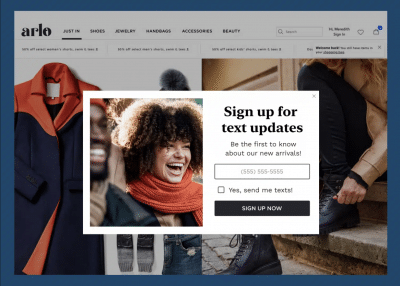Business
5 Tips to Build Your SMS List
May 3, 2023

Few businesses have remained unimpacted by the transformative power of digital technology. As we navigate the age of omni-channel marketing, the number of marketing and sales channels continues to expand, showing no sign of stopping. Consumers have more choices than ever and know the value of their business. As a result, marketers must focus on deepening relationships with their consumers to stay in line with their expectations and create personalized experiences that are relevant to their lives.
The Rise of Cross-Channel Marketing and Personalization
When 78% of consumers say checking, sending, and answering texts is the primary way they use their phones, it’s clear that SMS messaging has become an increasingly important marketing channel. SMS messages boast a well-known 98% open rate and the 2023 Consumer Trends Index found that 25% of respondents across all age groups made a purchase directly from an SMS they received in the last year. A recent survey of over 6,000 consumers found that more than 75% of the respondents favor brands whose messaging delivers a consistent user experience and treat them as an individual.
Tapping into this personalized and cost-effective channel has a clear ROI for deepening consumer relationships and elevating your brand. But like any marketing channel, it takes patience and persistence for results and a willingness to always stay one step ahead of the game.
Whether you’ve incorporated SMS into your cross-channel strategy – or if you’re starting to think about it – we’ve put together these simple steps to help you build and grow your SMS list.
1. Be Compliant with all Data Privacy Regulations
Marketers should never reach out to consumers who have not explicitly provided consent to receive SMS messages from your brand. Chances are it will be perceived as spam by the recipient. This could impact brand trust while also being in violation of policies regulating how businesses are allowed to use personal data like mobile phone numbers.
Consumers are savvier about privacy than ever before. They want plain language explaining how you’ll use their phone number. Make sure it’s clear they can unsubscribe at any time with a simple ‘STOP’ or by updating their permissions on your preference pages.
You can establish brand trust by:
- Explicitly asking the customer to opt-in and grant permission to receive SMS messages from your brand.
- Stating clearly how frequently you will be sending messages and what kinds of messages they will be as a part of the opt-in process (e.g.: delivery confirmation, order tracking, discount codes, or limited-time offers). And be sure to stay up to date with the privacy and protection regulations for your region.
2. Use Your Existing Email List
Two of the most important tools for launching your SMS strategy are likely already in your marketing toolbox: your email database and the power of a cross-channel marketing platform that can seamlessly capture and add SMS data to your existing customer profiles.
If you’re currently marketing to your subscribers via email, you have an advantage: an addressable base to start with. Since your subscribers already have an interest in your brand, you can use this as an opportunity to increase engagement and offer a worthwhile value exchange to excite them about receiving communications from you from a different channel (more on that in tip #4!) By sending an email campaign that drives your customers to a signup form, you can easily capture mobile numbers and SMS consent to use in future cross-channel marketing efforts.
3. Make Opting-In Simple, and Get Creative
The easier it is for your customers to share their information with you, the more likely they will be to do so. A seamless data-capturing experience should be as simple to execute for you as a marketer, as it is for customers to fill out – so you can focus on driving value and delivering a consistent and compelling customer journey. Here are three easy ways to start capturing data:
-Capture Opt-Ins at the Moment of Sign-Up
When viewers hit your paywall or decide to sign up for your email notifications or newsletters, make SMS opt-in part of the initial registration process by adding mobile number data capture and consent to your signup forms.

-Add SMS Opt-Ins to your Preference Center
Preference setting pages, or hosted pages, are another easy way for your new and existing consumers to sign up for SMS messaging – or simply update their current preferences. These hosted pages are fully customizable so you can give your consumers the power to choose which content they’d like to receive from you, including SMS communications.
-Create Sign-Up Opportunities Directly on Your Website
Targeted modals and banner bars, like Sailthru Overlays, can be placed on your website as an inviting way for your customers to enter their mobile numbers and consent to receive SMS messages from you. These data-capturing moments can be customized to enhance the brand experience, offer value to your subscribers, and ultimately – drive your SMS list growth.

4. Offer a High-Value Exchange to Drive Sign-up
A recent study on consumer trends found that 70% of consumers are willing to share their personal data if they receive something of value in exchange.
Entice your audiences to sign up for SMS messaging by offering something of value like free shipping, bonus content, or invitations to local events. Of course, what you offer will depend on your brand – but it should be a perk your customers can’t get any other way.
Need some ideas? Consumers are clear about what they value:
- 91% of shoppers are interested in loyalty rewards
- 86% want early and exclusive access to products and services
- 83% of consumers want to win a prize
- 61% are interested in bonus content
5. Keep Engagement High and Minimize Opt-Outs
As you roll out your SMS opt-in strategy, avoid being a nuisance to your customers by being upfront about your messaging frequency and what kind of offers and information they will receive. You’ll want to be clear about what your consumers are signing up for in exchange for their phone numbers. Once you set those expectations, it’s important to adhere to what you’ve promised.
To create effective SMS messages, personalization is crucial. Aim to keep recipients from feeling like they’re receiving generic mass communications by tailoring messages to their preferences and characteristics. Successful messages will feel personalized to each individual, rather than sound like they were sent to your entire marketing list.
Additionally, leverage segmentation tools to sort your customers into groups so that you don’t risk list fatigue. Segmented lists allow you to target users based on shared interests or behavior, improving your targeting and unsubscribe rates.
If your SMS opt-out rate goes higher than 3%, chances are your strategy needs to be refined. Marketers should continuously refine their tactics to stay closer to the 1% range.
Conclusion
Technology, coupled with a ubiquitous need to connect in real-time, offers people more ways to build relationships and get more personal. Consumers expect the brands in their lives to know them, understand them, remember what they love, and make it available to purchase with the tap of a finger.
Growing an SMS marketing list is more than simply collecting phone numbers. It’s about building trust with potential subscribers through clear communication and offering them a valuable reason to opt in. When you provide something of value to your subscribers in exchange for their contact information, you show your commitment to meeting their needs and building lasting connections, which can lead to continued list growth and long-term success.
If it’s time for you to launch your SMS strategy, learn how Sailthru can help you get started.
The State of Brand Loyalty in the U.S. in 2023
Related



